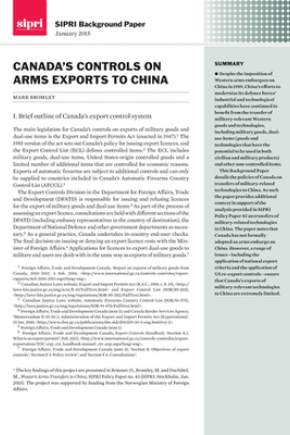Canada's Controls on Arms Exports to China
Despite the imposition of Western arms embargoes on China in 1989, China’s efforts to modernize its defence forces’ industrial and technological capabilities have continued to benefit from the transfer of military-relevant Western goods and technologies, including military goods, dual-use items (goods and technologies that have the potential to be used in both civilian and military products) and other non-controlled items.
This Background Paper details the policies of Canada on transfers of military-related technologies to China. As such the paper provides additional context in support of the analysis provided in SIPRI Policy Paper 43 on transfers of military-related technologies to China. The paper notes that Canada has not formally adopted an arms embargo on China. However, a range of issues—including the application of national export criteria and the application of US re-export controls—ensure that Canada’s exports of military-relevant technologies to China are extremely limited.
Related publications
Bräuner, O., Bromley, M. and Duchâtel, M., Western Arms Exports to China, SIPRI Policy Paper no. 43 (SIPRI: Stockholm, 2014).
Bromley, M., 'Norway's Controls on Arms Exports to China', SIPRI Background Paper, Jan. 2015.
Additional tables are also available as an online appendix.
About the author
Mark Bromley (United Kingdom) is Co-Director of SIPRI’s Dual-use and Arms Trade Control Programme, where his work focuses on national, regional and international efforts to regulate the international arms trade.
I. Brief outline of Canada’s export control system
II. National controls on exports to China

